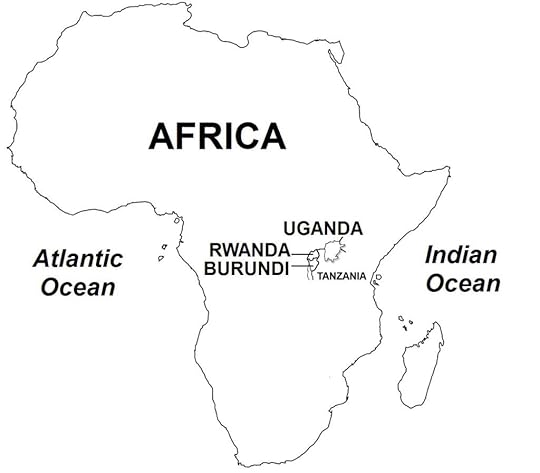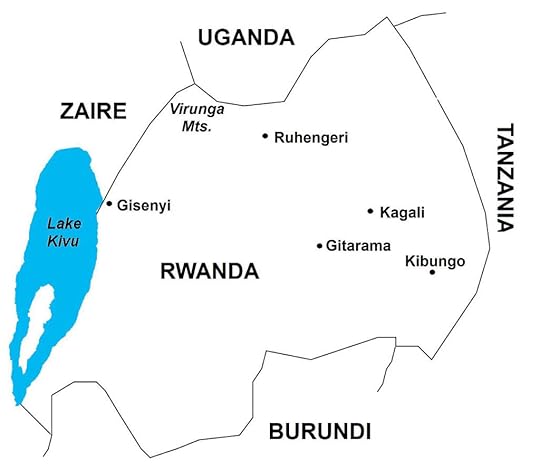April 6, 1994 – The start of the Rwandan Genocide, where 800,000 to one million people are killed
On April 6, 1994, Rwanda’s President Juvenal Habyarimina and Burundi’s head of state, Cyprien Ntaryamira, were killed by undetermined assassins when their plane was shot down by a rocket-propelled grenade as it was about to land in Kigali. A staunchly anti-Tutsi military government took over power in Rwanda. Within a few hours and in reprisal for the double assassinations, the new government unleashed the Interahamwe “death squads” to murder Tutsis and moderate Hutus on sight. Over the next several weeks, in the event known as the “Rwandan Genocide”, large numbers of civilians were murdered in Kigali and throughout the country. No place was safe; in some instances, even Catholic churches were the scenes of the massacres of thousands of Tutsis where they had taken refuge.

Africa showing location of Rwanda and other East African countries.
(Excerpts taken from Rwandan Civil War and Genocide – Wars of the 20th Century – Volume 2

Rwandan Civil War. In April 1994, the Rwandan Genocide was in full swing, with Hutus targeting Tutsis. From their bases in northern Rwanda, Tutsi rebels launched separate offensives aimed at Kibungo in the southeast, Ruhengeri in the north, and Kigali, Rwanda’s capital.
Background
Rwanda, a small country in Africa, experienced a long period of ethnic unrest before and after it gained its
independence in the 1960s. Then in the 1990s, this unrest culminated in two events known as the Rwandan Civil War and the Rwandan Genocide, both of which caused great loss in human lives and massive destruction of the country.
The conflict revolved around the hostility between Rwanda’s two main ethnic groups, the majority Hutus, who comprised 85% of the population, and the Tutsis, who made up 14% of the population. The origin of this hostility goes back many centuries to when a Tutsi monarchy was established in the Hutu-populated land of what is present-day Rwanda. Over time, the Tutsi monarch gained domination over the Hutus. The Tutsi monarch also acquired ownership over most of the land, which he divided into vast estates that were overseen by a hierarchy of Tutsi overlords, and worked by Hutu laborers in a feudal-type system. For the most part, however, Tutsis and Hutus lived in harmony. In the course of time, some Hutus became
wealthy, while many ordinary, non-aristocratic Tutsis remained poor.
Rwandan Genocide
On April 6, 1994, President Habyarimina and Burundi’s head of state, Cyprien Ntaryamira, were killed by undetermined assassins when their plane was shot down by a rocket-propelled grenade as it was about to land in Kigali. A staunchly anti-Tutsi military government took over power in Rwanda.
Within a few hours and in reprisal for the double assassinations, the new government unleashed the Interahamwe “death squads” to murder Tutsis and
moderate Hutus on sight. Over the next several weeks, in the event known as the “Rwandan Genocide”, large numbers of civilians were murdered in Kigali and throughout the country. No place was
safe; in some instances, even Catholic churches were the scenes of the massacres of thousands of Tutsis where they had taken refuge.
The attackers used clubs, spears, firearms, and grenades, but their main weapon was the machete, with which they had trained extensively and which they used to hack away at their victims. At the urging of local officials, Hutu civilians joined in the killing frenzy, and turned against their Tutsi neighbors,
acquaintances, and even relatives. In many cases, the threat of being killed for appearing sympathetic to Tutsis forced many otherwise disinterested Hutus to participate.
The Rwandan Army provided the Interahamwe with a list of Tutsis to be killed, and raised road blocks to prevent any escape. The death toll in the Rwandan Genocide ranges from between 800,000 to one million; some 10% of the fatalities were moderate
Hutus. The genocide lasted for about 100 days, from between April 6 to July 15, producing a killing rate of 10,000 persons a day. The speed by which it was
carried out makes the Rwandan Genocide the fastest in history. (By comparison, the Holocaust in Europe during World War II, although producing a much
higher death toll, was carried out over a number of years.)
During the course of the genocide, the UN force in Rwanda was ordered not to intervene by the UN Secretary General. In any case, the UN force was seriously undermanned and only lightly armed to stop the widespread violence.
The UN peacekeepers, however, managed to protect the civilians inside their zone of authority.
Shortly after the violence began, foreign diplomats and their staff from the various embassies in Kigali
fled the country. Other civilian expatriates were evacuated as well. The international community, including the Western powers, chose not to intervene
in the genocide or misread the upsurge in violence as just another combat phase in the civil war.



